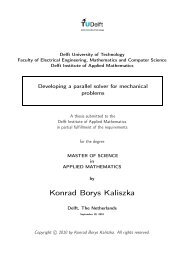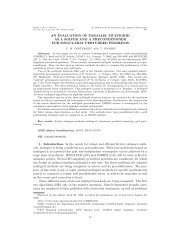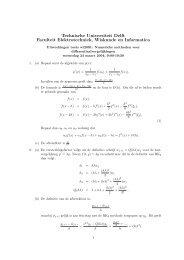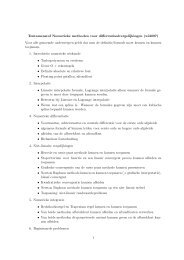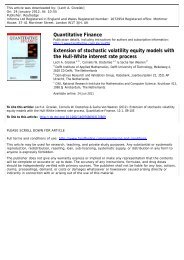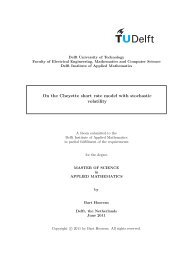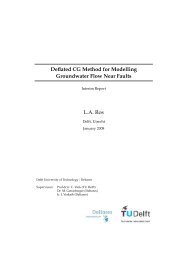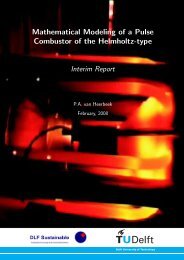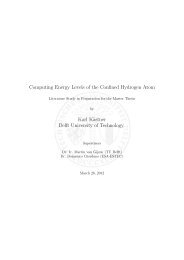Gerard L.G. Sleijpen, Peter Sonneveld and Martin B. van Gijzen, Bi ...
Gerard L.G. Sleijpen, Peter Sonneveld and Martin B. van Gijzen, Bi ...
Gerard L.G. Sleijpen, Peter Sonneveld and Martin B. van Gijzen, Bi ...
You also want an ePaper? Increase the reach of your titles
YUMPU automatically turns print PDFs into web optimized ePapers that Google loves.
Author's personal copy<br />
G.L.G. <strong>Sleijpen</strong> et al. / Applied Numerical Mathematics 60 (2010) 1100–1114 1101<br />
as a result are often much more efficient, both with respect to memory <strong>and</strong> to computations, for problems where GMRES<br />
needs many iterations to find a sufficiently accurate solution.<br />
Krylov subspace methods grow in each iteration. This makes it possible to construct increasingly better approximate<br />
solutions using a suitable selection criterion. Efforts of finding appropriate approximate solutions have mainly focused on<br />
constructing residuals with small or smallest norm. For instance, for symmetric systems (i.e. A ∗ = A), CR (conjugate residuals)<br />
constructs residuals with smallest Euclidean norm, while the residuals for CG (conjugate gradients) have smallest<br />
A −1 -norm. <strong>Bi</strong>-CG has been viewed as a CG process with respect to a quadratic form rather than an inner-product, <strong>and</strong><br />
residuals were considered to be ‘minimized’ with respect to this quadratic form.<br />
<strong>Bi</strong>-CGSTAB is a combination of two methods, of <strong>Bi</strong>-CG <strong>and</strong> restarted GMRES (or GCR). In the restarted GMRES part,<br />
a residual is minimized in each step, in the <strong>Bi</strong>-CG part, the <strong>Bi</strong>-CG process is incorporated. The focus in <strong>Bi</strong>-CGSTAB is on<br />
preserving the <strong>Bi</strong>-CG coefficients, hoping that the nice features of <strong>Bi</strong>-CG (read ‘residual minimization’) are transferred to<br />
<strong>Bi</strong>-CGSTAB.<br />
An alternative approach has been taken in [12] in the construction of the IDR (induced dimension reduction) method,<br />
‘squeezing’ the residuals to zero. The IDR method finds residuals in a sequence of shrinking subspaces. <strong>Bi</strong>-CGcanalsobe<br />
viewed in such a perspective. <strong>Bi</strong>-CG residuals belong to a sequence of growing Krylov subspaces, but they also belong to a<br />
sequence of shrinking subspaces: <strong>Bi</strong>-CG uses so-called ‘shadow’ Krylov subspaces K k (A ∗ , ˜r 0 ) for testing, that is, the residuals<br />
are constructed to be orthogonal to this sequence of growing shadow spaces. The starting point for the IDR construction is<br />
more abstract, more elegant than for <strong>Bi</strong>-CG. Residuals are constructed in spaces G k that are defined recursively by G k+1 =<br />
(I − ω k A)(G k ∩ S) (see Section 2). Here, S is a fixed proper subspace of C n .IfA has no eigenvector that is orthogonal to the<br />
subspace S, thenG k+1 ⊂ G k <strong>and</strong> the dimension of G k reduces with increasing k (see also Theorem 7 below).<br />
The subspace S in the original IDR paper [12] from 1980 consists of all vectors orthogonal to some (r<strong>and</strong>om) vector ˜r 0 .<br />
The method turned out to be very effective. In fact, as effective as the more recent <strong>Bi</strong>-CGSTAB method (from 1992). Unfortunately,<br />
the original formulation of the IDR algorithm contained some instabilities, <strong>and</strong> IDR did not gain the popularity of<br />
<strong>Bi</strong>-CGSTAB. In a recent paper [10], it was shown that the IDR concept allows elegant incorporation of a smaller fixed subspace<br />
S, or, equivalently, of a space of vectors orthogonal to all columns of an n × s matrix ˜R0 with s > 1. The idea to use a<br />
subspace S with co-dimension s combined with a more stable computation of the residuals <strong>and</strong> approximate solutions led<br />
to the IDR(s) algorithm. For s = 1, this algorithm is mathematically equivalent to the original IDR method, but has superior<br />
numerical stability. Moreover, the numerical experiments in [10] show that, for modest values of s, ass = 4, even for ‘tough’<br />
linear equations, IDR(s) often achieves almost the same convergence as GMRES, that is, comparable accuracy for the same<br />
number of MVs. However, the additional costs per MV in IDR are modest <strong>and</strong> limited (as with <strong>Bi</strong>-CGSTAB), whereas these<br />
costs in GMRES grow proportional to the iteration step.<br />
In Section 4 of this paper, the IDR principle is formulated in terms of Krylov subspaces. Although this formulation is<br />
less elegant, it may provide more insight, since it facilitates comparison of IDR <strong>and</strong> <strong>Bi</strong>-CGSTAB type of methods, <strong>and</strong> it may<br />
lead to even more effective variants. In Section 5, we give an alternative proof from the one [10, §5.2] of the mathematical<br />
equivalence of IDR(s) with s = 1 <strong>and</strong> <strong>Bi</strong>-CGSTAB. The proof here gives a more detailed relation <strong>and</strong> also serves as an<br />
introduction to the subsequential sections. Via a block variant of <strong>Bi</strong>-CG in Section 6, we explain in Section 7 how the case<br />
s > 1 can be incorporated in <strong>Bi</strong>-CGSTAB as well, yielding a variant that is equivalent to IDR(s) (see Section 8).<br />
Our block variant of <strong>Bi</strong>-CG uses blocks of size p = 1 (that is, n-vectors) in the search Krylov subspace, <strong>and</strong> blocks of<br />
size s (that is, n × s matrices) for testing. The focus in literature on block methods is mainly on the case where the size<br />
p of the blocks for searching <strong>and</strong> the size s of the blocks for testing are equal (p = s, cf., e.g., [5,4,6]). A general block<br />
Lanczos version (with p ≠ s ) has been discussed in [1]. There is no <strong>Bi</strong>-CGSTAB version. The case where p > 1<strong>and</strong>s = 1<br />
for <strong>Bi</strong>-CGSTAB has been discussed in [3]. The purpose of all these papers is to develop methods for solving block systems,<br />
also called multiple right-h<strong>and</strong> side system, i.e., systems where b is an n × p matrix with p > 1. IDR(s), however, aims for<br />
fast convergence for the single right-h<strong>and</strong> side case (i.e., p = 1) by using higher dimensional blocks (s > 1) for testing. One<br />
paper [13] works in precisely our setting (p = 1, s > 1). This interesting paper generalizes the <strong>Bi</strong>-CG polynomial recursions<br />
to derive the block <strong>Bi</strong>-CGSTAB variant ML(k)<strong>Bi</strong>CGSTAB. Unfortunately, this derivation leads to complicated formula’s, which<br />
makes the exposition rather intransparant. Also, their experiments concentrate on high values of s (e.g. s = 100), where, in<br />
our experience, only low values of s are attractive. We feel that the subspace formulation of IDR is more elegant <strong>and</strong> more<br />
flexible. In this paper we bridge the subspace approach <strong>and</strong> the polynomial one.<br />
The purpose of this paper is to provide insight. Therefore, we focus on mathematical concepts rather than on technical<br />
details. The new algorithms that we describe in this paper should therefore not be considered as matured, but as bridging<br />
steps between the <strong>Bi</strong>-CGSTAB approach <strong>and</strong> the IDR approach, with the ultimate goals to improve both types of algorithms.<br />
1.1. Some remarks on the notation<br />
Notation 1. As a general rule, we will use notations <strong>and</strong> terminology that are common in the literature about <strong>Bi</strong>-CG methods.<br />
Our notation is therefore different from the one used in [10]. For example, we will use the term ‘shadow space’ for the space<br />
spanned by the columns of a matrix ˜R. This terminology <strong>and</strong> notation is linked to the ‘shadow residuals’ in <strong>Bi</strong>-CG. In IDR,<br />
S is the left-Null space of ˜R, <strong>and</strong> is unrelated to the concept of a shadow residual.




